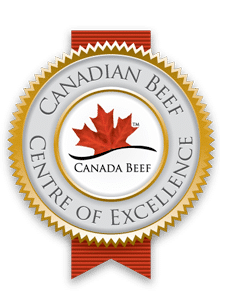It goes without saying that to cook beef consistently, you need equipment that is functioning well and can meet the rigours of the kitchen.

Grilling Charbroilers
The key to charbroilers is a consistent high heat and quick recovery time. The objective of grilling is to sear the meat, so if the temperature is not sufficient, the meat will boil and become tough. Most standard charbroilers operate between 220°C/430°F and 280°C/550°F. A grill thermometer is a handy tool to periodically check grill temperature. The broiler should have all jets working and be free of excess char. To prevent “off-flavours”, use a wire brush to clean grill bars. There have been many technological advances in manufacturing broilers such as infrared heating and drawer style broilers that heat from both top and bottom. Whatever the style, make sure the broiler has the heat and capacity to handle the busiest shifts effectively.
Roasting
There are many types of oven equipment on the market today but roasting equipment can be broken into two basic styles.
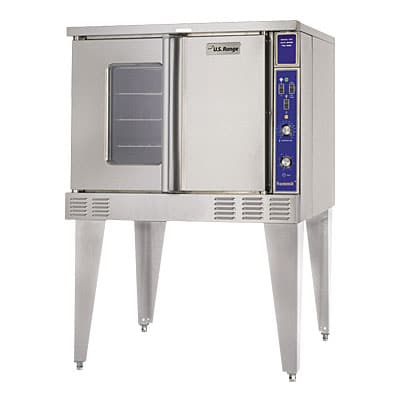 Conventional/Convection Ovens are most often found in commercial kitchens. The main difference between them is that convection ovens have a fan in the back to help circulate air around the oven, thus enhancing cooking and browning. Conventional ovens deliver heat from the bottom which fills the oven cavity. When roasting beef in these ovens, the temperature greatly impacts the cooked yield of the product. For large roasts, a temperature of between 120°C/275°F and 160°C/325°F will help to achieve the best results. If using a convection oven with the fan on, reduce the temperatures listed by 25°F. Keep an oven thermometer close by. “Low and Slow” is the key to maximizing beef quality and cooked yield in these ovens.
Conventional/Convection Ovens are most often found in commercial kitchens. The main difference between them is that convection ovens have a fan in the back to help circulate air around the oven, thus enhancing cooking and browning. Conventional ovens deliver heat from the bottom which fills the oven cavity. When roasting beef in these ovens, the temperature greatly impacts the cooked yield of the product. For large roasts, a temperature of between 120°C/275°F and 160°C/325°F will help to achieve the best results. If using a convection oven with the fan on, reduce the temperatures listed by 25°F. Keep an oven thermometer close by. “Low and Slow” is the key to maximizing beef quality and cooked yield in these ovens.
Combination Ovens combine both steam and dry heat at various times during the cooking process to help cook quicker and produce a high yield. Cook and hold units cook beef roasts over a longer period of time at a lower temperature and are equipped with an internal probe that senses desired temperature and automatically turns the temperature down to a holding mode.


 Using high heat to sear the outsides of a cut and to maintain moisture on the inside — most often associated with steaks and smaller cuts (kebobs, etc.). The natural benefits are maintaining juiciness and preparing the product to the guests’ desired doneness level.
Using high heat to sear the outsides of a cut and to maintain moisture on the inside — most often associated with steaks and smaller cuts (kebobs, etc.). The natural benefits are maintaining juiciness and preparing the product to the guests’ desired doneness level. Done in an oven environment, heat surrounds the cut and slowly increases the internal temperature until the desired doneness is reached. Larger cuts are generally candidates for roasting and achieve high cooked yield and even doneness throughout.
Done in an oven environment, heat surrounds the cut and slowly increases the internal temperature until the desired doneness is reached. Larger cuts are generally candidates for roasting and achieve high cooked yield and even doneness throughout.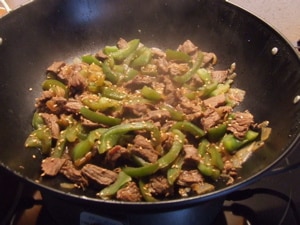 This method utilizes a small amount of hot oil in a pan or wok to quickly cook the beef and maintain moisture and tenderness. The advantage with sautéing is that flavour is easily enhanced when cooked with other ingredients.
This method utilizes a small amount of hot oil in a pan or wok to quickly cook the beef and maintain moisture and tenderness. The advantage with sautéing is that flavour is easily enhanced when cooked with other ingredients.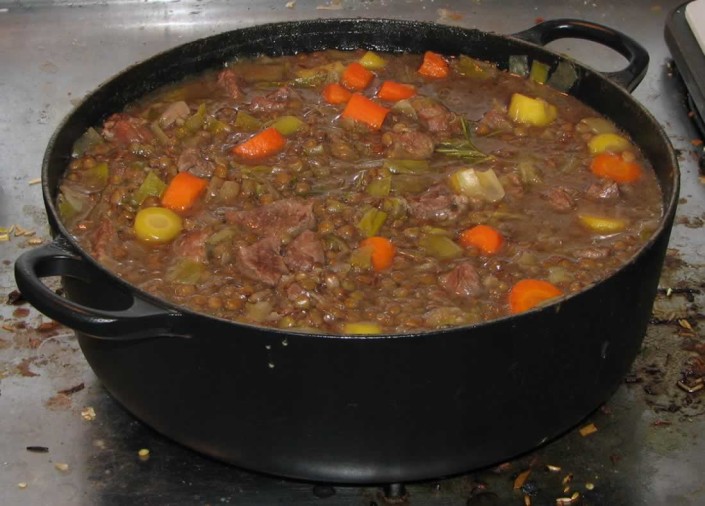 Small pieces of beef are browned and immersed in a liquid (stock, wine, etc.) often with vegetables added. The covered pot is simmered slowly until the beef is tender. Strong flavours are developed with stewed beef dishes.
Small pieces of beef are browned and immersed in a liquid (stock, wine, etc.) often with vegetables added. The covered pot is simmered slowly until the beef is tender. Strong flavours are developed with stewed beef dishes.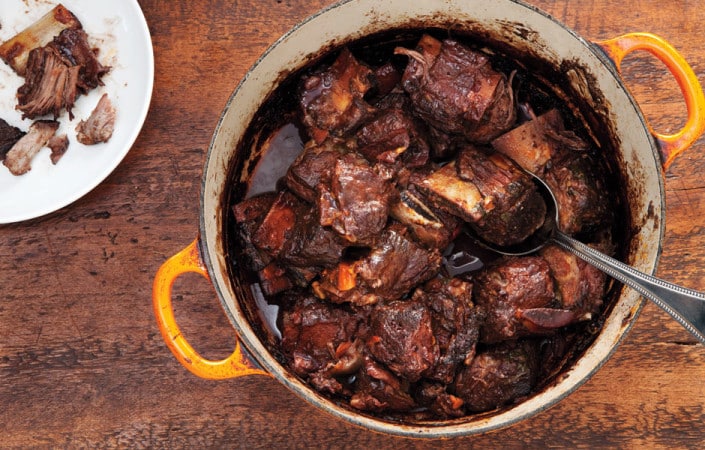 Similar to stewing, the beef cuts are browned, vegetables added, and a liquid is added to cover one-third of the meat. A lid is placed on the pot and the dish is cooked slowly in an oven or on stove top. The combination of steam and pressure created in the pot breaks down the connective tissues in the beef.
Similar to stewing, the beef cuts are browned, vegetables added, and a liquid is added to cover one-third of the meat. A lid is placed on the pot and the dish is cooked slowly in an oven or on stove top. The combination of steam and pressure created in the pot breaks down the connective tissues in the beef.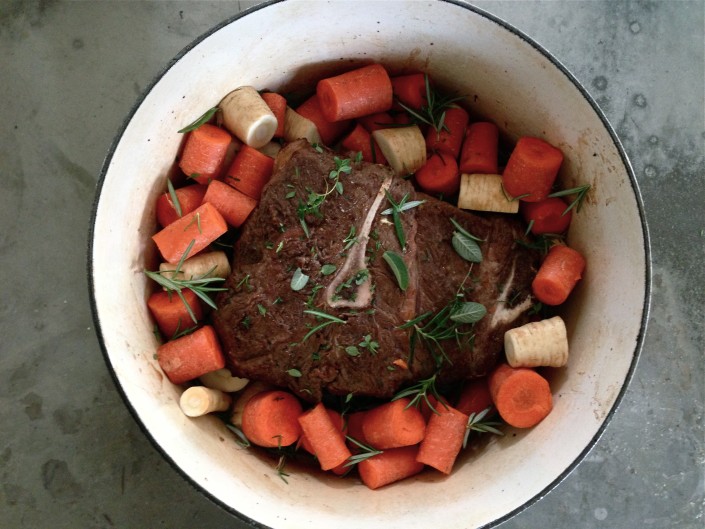 Usually used for larger, less tender cuts, this method involves browning the beef, adding stock/wine to cover 1/3 of the meat, and covering. The pot roast is placed in a low-temperature oven.
Usually used for larger, less tender cuts, this method involves browning the beef, adding stock/wine to cover 1/3 of the meat, and covering. The pot roast is placed in a low-temperature oven.





 This is a process in which the beef is covered in a marinade containing natural tenderizers that break down the connective tissue. Marinades can come in many forms – from simple wet marinades to elaborate cooked marinades. Examples of natural products that break down connective tissue are:
This is a process in which the beef is covered in a marinade containing natural tenderizers that break down the connective tissue. Marinades can come in many forms – from simple wet marinades to elaborate cooked marinades. Examples of natural products that break down connective tissue are:
 Conventional/Convection Ovens are most often found in commercial kitchens. The main difference between them is that convection ovens have a fan in the back to help circulate air around the oven, thus enhancing cooking and browning. Conventional ovens deliver heat from the bottom which fills the oven cavity. When roasting beef in these ovens, the temperature greatly impacts the cooked yield of the product. For large roasts, a temperature of between 120°C/275°F and 160°C/325°F will help to achieve the best results. If using a convection oven with the fan on, reduce the temperatures listed by 25°F. Keep an oven thermometer close by. “Low and Slow” is the key to maximizing beef quality and cooked yield in these ovens.
Conventional/Convection Ovens are most often found in commercial kitchens. The main difference between them is that convection ovens have a fan in the back to help circulate air around the oven, thus enhancing cooking and browning. Conventional ovens deliver heat from the bottom which fills the oven cavity. When roasting beef in these ovens, the temperature greatly impacts the cooked yield of the product. For large roasts, a temperature of between 120°C/275°F and 160°C/325°F will help to achieve the best results. If using a convection oven with the fan on, reduce the temperatures listed by 25°F. Keep an oven thermometer close by. “Low and Slow” is the key to maximizing beef quality and cooked yield in these ovens.